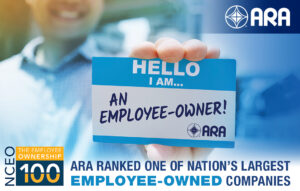Technology demonstrations help protect the nation by developing, delivering, and sustaining affordable, technologically-advanced capabilities
Applied Research Associates Inc. (ARA) organized and supported two large-scale technology demonstrations in conjunction with military training exercises in an effort to improve safety and security at U.S. military installations while maximizing return on research, development, testing, and evaluations (RDT&E) dollars.
These exercises were collaborative efforts to provide physical security solutions to reduce risk, address prioritized capability gaps, and serve as the catalyst for analyzing, developing, and demonstrating interoperable systems for DoD-wide requirements to mitigate future threats.
One of the exercises, the Army’s Military Ocean Terminal Concept Demonstration (MOT CD), took place at the Military Ocean Terminal in Concord, Calif. while the second, the Citadel Protect Technology Demonstration (CPTD), was held at San Diego Naval Base, Calif. Both took place over multiple weeks in September 2017.
At each demonstration, industry partners along with government labs were selected to demonstrate emerging mid-TRL level technology that had the potential to replace or enhance existing legacy systems to close or mitigate current capability gaps. Scripted scenarios involving active shooters, waterborne Improvised Explosive Devices, insider threats, and counter Unmanned Aerial Systems were designed to provide a real-world training environment to gain better data capture and warfighter feedback on the technology selected to demonstrate, explained Adam Nowinowski, ARA’s Project Support Lead.
Based on the employment outcomes along with immediate warfighter feedback, the technology provider can quickly update or enhance the technology to better suit warfighter needs before it’s fielded.
“AT THE END OF THE DAY, THE OBJECTIVE WAS TO DEMONSTRATE NEW AND EMERGING TECHNOLOGY THAT COMPLETELY REPLACES OR ENHANCES EXISTING LEGACY SYSTEMS, EITHER CLOSING OR MITIGATING CAPABILITY GAPS, BEING A TRUE FORCE MULTIPLIER WHILE INCREASING THE OVERALL SECURITY POSTURE AT THESE LOCATIONS.” – ADAM NOWINOWSKI, PROJECT SUPPORT LEAD.
Each of the demonstrations took more than a year to plan, design, coordinate, execute and provide after action analysis. Often, RDT&E technology ends up “not getting the appropriate visibility and good capabilities are left sitting on a shelf collecting dust,” Nowinowski said. It’s a DoD-wide problem, but stakeholders hope these types of exercises will facilitate the transition of capabilities.
Senior-level stakeholders provided positive feedback on both events and have requested a budget line increase for funding to move forward and continue to do the exercises with new and emerging technology demonstrations also integrated on a regular basis, along with some immediate procurement activities.
“The methodology here, the concept that’s new, is putting this equipment at a very early R&D level into the hands of warfighters during real world training scenarios,” Nowinowski said. “This allows for a two-way dialogue between the technology provider and the warfighter, thus aiding in concept of operation development, and provides a more seamless transition once it gets fielded and into the hands of the warfighter. That way, the warfighter can be trained on a new piece of equipment, understanding not only how to properly utilize the capability to maximum potential, but also understand how it integrates into current rules of engagement and escalation of force decision making.”
Dozens of government and commercial entities, along with hundreds of military personnel, participated.
“The end-to-end coordination itself is a huge undertaking,” Nowinowski said, and a “resounding success.”




